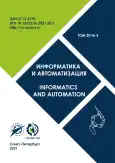The paper presents the results of statistical data from open sources on the development of the COVID-19 epidemic processing and a study сarried out to determine the place and time of its beginning in Russia. An overview of the existing models of the processes of the epidemic development and methods for solving direct and inverse problems of its analysis is given. A model for the development of the COVID-19 epidemic via a transport network of nine Russian cities is proposed: Moscow, St. Petersburg, Nizhny Novgorod, Rostov-on-Don, Krasnodar, Yekaterinburg, Novosibirsk, Khabarovsk and Vladivostok. The cities are selected both by geographic location and by the number of population. The model consists of twenty seven differential equations. An algorithm for reverse analysis of the epidemic model has been developed. The initial data for solving the problem were the data on the population, the intensity of process transitions from one state to another, as well as data on the infection rate of the population at given time moments. The paper also provides the results of a detailed analysis of the solution approaches to modeling the development of epidemics by type of model (basic SEIR model, SIRD model, adaptive behavioral model, modified SEIR models), and by country (in Poland, France, Spain, Greece and others) and an overview of the applications that can be solved using epidemic spread modeling. Additional environmental parameters that affect the modeling of the spread of epidemics and can be taken into account to improve the accuracy of the results are considered. Based on the results of the modeling, the most likely source cities of the epidemic beginning in Russia, as well as the moment of its beginning, have been identified. The reliability of the estimates obtained is largely determined by the reliability of the statistics used on the development of COVID-19 and the available data on transportation network, which are in the public domain.
 1010-1033
1010-1033


 1034-1065
1034-1065


 1066-1090
1066-1090


 1091-1116
1091-1116


 1117-1154
1117-1154


 1155-1182
1155-1182











